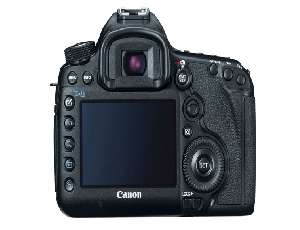
The Canon EOS 5D Mark III, which was announced at the stroke of midnight last night, is an HDSLR that builds on the unprecedented success of its predecessor, the Canon EOS 5D Mark II. The 5DMII broke new ground in the world of HD video, offering true high-resolution, cinema-quality video capture for the first time in a DSLR. It started a revolution in cinematography that continues to this day. Now, the 22-megapixel Canon EOS 5D Mark III, with its ability to capture 1080p video, and sophisticated new sensor, focusing, and metering systems, promises to take this still photography and cinematic legacy to new heights.
Note: Adorama is now accepting pre-orders for the Canon EOS 5D Mark III. Orders will be fulfilled on a first-come, first-served basis. Credit cards will not be charged until orders are shipped.
Key features include:
- New full frame (36x24mm), 22 megapixel CMOS sensor
- ISO range 100-25600, expandable to 104,200.
- 14-bit A/D conversion
- Shutter speeds 1/8000-30 seconds
- New 63-zone dual layer iFCL Metering
- Exposure compensation in +/- 5 stops in 1/3 or 1/2-stop increments
- New 61-point high-density reticular AF with up to 41 cross-type points
- New 3.2-inch LCD finder with 1.04 million dot resolution
- 1080p HD video capture in AVI, RAW, H.265, MOV and MPEG-4
- Manual exposure control and multiple frame rates in videos
- CF and SD card slots
- 6 fps burst rate
- HDR mode combining three exposures with adjustable settings
- Magnesium-alloy body, enhanced dust and weather resistance
- New customizable controls
- Electronic level
- Claimed shutter durability of 150,000 cycles
- Slilent & Low vibration modes
Also read: Canon EOS 5D Mark III: First Look

New sensor, focusing, and metering systems
The Canon EOS 5D Mark III is built around a new 22.3 megapixel full-frame, self-cleaning CMOS sensor. Canon promises high perforance and claims improved noise reduction at higher ISOs with its DIGIC 5+ sensor, and up to 6 frames per second burst rate in RAW and JPEG. Additional technological advancements include an Intelligent Viewfinder with a dual-axis level indicator, Canon’s advanced iFCL metering system, High Dynamic Range (HDR), and Multiple Exposure mode.
A newly-designed 61-Point High-Density Reticular AF system (which first appeared in the flagship Canon EOS-1D X pro DSLR) is said to be Canon’s most sophisticated AF to date, featuring multi-zone wide-area AF for better tracking. A new dedicated AF menu tab saves users from digging through menu functions. The new Multi-layer iFCL (intelligent Focus Color Luminance) metering system takes color and luminosity surrounding chosen AF points into account, which Canon says will provide new levels of accuracy in fast-changing, tricky light.
Another new feature is High Dynamic Range (HDR); the Canon EOS 5D Mark III can merge three images at different exposures to create a final image with a broad range of shadow and highlight detail. In-camera HDR can cover a range up to +/- 3 stops in five different settings. The camera’s control layout has been changed, with Canon adding more customizable controls and a new ergonomic design.

Improvements in video capture
The video and cinema industries have been eagerly anticipating the Canon EOS 5D Mark III for improvements over its groundbreaking predecessor. Canon claims the 5D Mark III can capture HD video with a level of sophistication on par with professional movie cameras offering phenomenal performance on a DSLR. It offers both All-I and IPB compression, supports H.264/MPEG-4 AVC High Profile, and automatically splits files greater than 4GB (FAT specifications) for extended recording without interruption.
The Canon 5D Mark III offers the option of timecoding during recording only (Rec Run) or at all times (Free Run), a useful feature for multi-camera shoots. It also offers improved sound recording adjustment capabilities, with 64-step volume control, plus a dedicated headphone jack. The CMOS sensor’s new drive system is said to significantly increas image processor performance, reducing color artifacts and moiré (a common problem that occurs in scenes with horizontal lines), and ensures that the EOS 5D Mark III can record at a number of frame rates up to ISO 25600 in H mode.
New Speedlite Flash and Transmitter announced
In addition to the 5D Mark III, Canon introduced its first new shoe-mount flash with a built-in wireless radio transmitter, the Canon Speedlite 600EX-RT. The new flagship Speedlite, it offers Master-Slave two-way transmission and can be used in configurations of up to 15 600EX-RT slave off-camera as far as 94.8 feet from the master. Also announced is the Canon Speedlite Transmitter ST-E3-RT, which supports Canon’s radio-based wireless flash by controlling up to five groups of flashes and lets a photographer control up to 15 Canon EOS cameras simultaneously.
Pricing and Availability
The Canon EOS 5D Mark III is expected at the end of March for approximately $3,499 body only, or with the EF 24-105mm f/4L IS USM zoom lens for $4,299. The WFT-E7A Wireless File Transmitter will be available by the end of April for $849.99. The GPS Receiver GP-E2 is expected by late April for $390. The Battery Grip BG-E11 is als scheduled for the end of April and will cost $490. The Speedlite 600EX-RT and Speedlite Transmitter ST-E3-RT are also scheduled for end of March availability for $629.99 and $470, respectively.
Read our in-depth report about the Canon EOS 5D Mark III.

